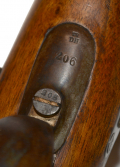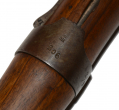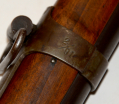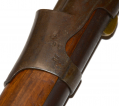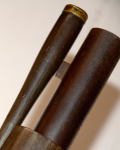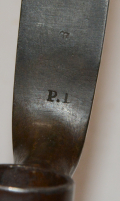site search
online catalog
6th OHIO INFANTRY SHILOH INSCRIBED PRESENTATION DRESDEN RIFLE AND BAYONET

$6,500.00 SOLD
Quantity Available: None
Item Code: 1164-03
This rifle musket bears a wonderful engraved script presentation on the barrel flats near the breech reading: “From Capt. J.W. Wilmington 6th Ohio V.I. / To Geo. Burrows, Camp Shiloh / Pitsburg Landing Tenn. /April 6. & 7. 1862.” (We have preserved the spelling.) The giver of the gun was Captain James Willis Wilmington, a former lieutenant of the Independent Guthrie Grays of Cincinnati who had also served in the three-month incarnation of the 6th Ohio, and is documented as present at Shiloh- see the anecdote below. The presentation is not dated, but must predate Wilmington’s death in 1866 and his departure from Cincinnati for Nevada and parts west about 1864, and most likely dates to the regiment’s camp on the Shiloh battlefield from April 6 to May 2, 1862, when it was visited by many Cincinnati residents.
The rifle itself is a Model 1851 Saxon Rifle Musket, one of many European arms imported by U.S. dealers and purchasing agents to arm the large number of new soldiers in the first two years of the war. The M1851 differed from the M1857 only in barrel length. Both were well regarded by U.S. Ordnance officers, likely in part for their .58 caliber, and were rated as first class arms. Both patterns, and likely others, seem to have been among 27,055 arms bought by U.S. purchasing agent George Schuyler in 1861 from the armory at Dresden. This has led to calling them Dresden rifles in some collector circles, but they were made in Liege and so marked, creating many Civil War period references to them as “Belgian rifles.” Under this title they were apparently carried by the 6th Ohio: in January 1862 troops in their division were instructed by Gen. Nelson to exchange arms, “so that no regiment should have rifles of different calibers.” The 6th Ohio then traded off .69 caliber conversion muskets to the 15th and 50th Indiana for Enfield rifles and “Belgian rifles.” Given that the point of the trade was to have guns using the same ammunition and the .577 caliber Enfield and .58 Saxon could both use the .58 U.S. cartridges, the Saxon is the perfect candidate for the 6th Ohio’s “Belgian” rifles.
This is the standard configuration, most easily recognizable by its double-strapped middle band. The rifle is complete, with all bands, springs, swivels and rod in place. The lockplate is maker marked, “P.J. MALHERBE / A LIEGE.” Most of the parts have assembly numbers (206 – perhaps the final digits of the serial number) and there are a number of fractional ciphers that are likely Saxon rack numbers: “2/91,” along with small crowned inspection stamps and a serial number, 40206, on the lower left barrel flat. The rear sight is a fixed block rather than a block with leaves, either in accordance with the 1851 versus 1857 pattern, an alteration when the gun was being sold from the armory, or the use of both types of rear sight, as on Austrian Lorenzes. The condition is about excellent, with smooth metal and tight fitting wood with good edges. The barrel preserves a lot of blue and there are visible case colors on the lockplate, hammer, and even the breechplug tang and buttplate. The bands show a thin caramel or smokey brown. The wood is excellent as well, good edges, good ramrod channel, nice warm brown color with visible grain, good surface, and very few handling marks, scratches or stains. Wilmington may have picked it up on the field or simply acquired it from regimental stores. In either case, he chose a very nice example and it has been kept that way.
Wilmington, who shows up in some records by his middle name, was born about 1839 and was a printer involved in the newspaper business in Cincinnati when he enlisted. He was also a writer, furnishing some accounts of army life to Cincinnati newspapers under the pseudonyms “Nemo” and “Haversack.” He was a member of the prewar Cincinnati militia unit, the “Independent Guthrie Grays,” who formed the nucleus of the 6th Ohio Infantry both in its three-month and then three-year incarnation, going into service initially as 1st Lieutenant of the Second Company of the Grays, a post to which he had just been elected on April 1, 1861. In the organization of the regiment to a three-year unit in May and June, he was elected Captain of Company C, taking a commission dating 6/12/61 and serving until he was accidentally wounded in late May 1862, took sick leave to recover and resigned as of July 6.
The regiment organized at Camp Denison, OH, on 6/18/61 and took an active part in the campaign in western Virginia, returning to Ohio in late November and moving into Kentucky in December, to Nashville in February 1862 and by April 5 were posted at Savannah, Tennessee, on the Tennessee River, just northwest of Pittsburg Landing. On the morning of April 6, 1862, they took up the march toward the battle and were among the first of Buell’s troops to cross the river, supporting troops who repelled the last of the Confederate charges that day. They were not heavily engaged, but were under fire throughout the next day and took casualties.
The regimental commander’s official report to the brigade commander reads as follows: “The regiment was disembarked at about 5 o'clock on the evening of the 6th instant, and marched up the hill as quickly as possible amid the confusion and panic existing among some disorganized regiments at the landing place. I formed line of battle, under your directions, some 200 yards from the river, to support a battery then in danger of being charged by the enemy. The regiment laid on arms all night, two companies acting as skirmishers. At daylight on the 7th the brigade formed in line of battle, skirmishers in advance, the Sixth Regt. holding the right. About a mile from the place we had occupied in the night our advance met the enemy, and the battle was immediately opened. During the day the regiment was continually under a hot and heavy fire, supporting for the greater time Terrill's regular battery, and at one time furnishing a company to manage the guns of said battery, its men having been mostly killed or wounded. The regiment was held as a reserve, and once changed front perpendicular to the rear, and once forward on the first company, in order to re-enforce our hotly-attacked lines. Late in the afternoon we advanced briskly forward and occupied the left of the ground once occupied by Stuart's brigade, which had been all day in the possession of the enemy. At no time were we actively engaged in the fight, although the regiment acted with the greatest coolness and promptitude on every order that was given them. Our loss is 2 killed, 2 missing, and 5 wounded.” That Wilmington was on the field is known from an anecdote in the regimental history: at one point during their advance on the second day he admonished a soldier lying on the ground, telling him to get up and out of the way of an advancing artillery piece, eventually turning over the unresponsive figure to find he had been shot in the forehead.
The regiment remained in camp at Pittsburgh Landing until May 2, when it marched for Corinth. The regimental history records the visit of numbers of Cincinnati residents seeking to aid the wounded, etc. We have not identified the George Burrows who received the gun from Wilmington, but the presentation likely took place in this period given the reference to “Camp Shiloh.” Wilmington was with the regiment in the movement upon and siege of Corinth in May, which Buell had touted as going to be, “short, sharp and decisive,” but under Halleck became a, “solemn farce of a four-weeks siege” in the words of the regimental history. During the siege Wilmington was accidentally wounded in the leg on May 31. He was given a sick leave to recover, but submitted his resignation a few weeks later, which was accepted as of 7/6/62. We find him back in Cincinnati as a printer in the 1863 city directory, but he developed an urge to travel west. The regimental history says he died on an ocean voyage, but this seems to be a misinterpretation of his death “on the Pacific Coast,” as appears in an obituary in the Cincinnati Daily Enquirer of 30 September 1866:
“Death of Mr. Willis Wilmington
The friends and acquaintances of Mr. Willis Wilmington, for many years, well known as the foreman of the job office in this establishment, will regret to learn of his decease. It occurred, a few weeks since, on the Pacific coast, as we learn from letters received from that section of the country. Mr. Wilmington left the Enquirer in the Spring of 1861, and entered the army as a Captain in the 6th Ohio. He served two years, resigned, and went to Nevada at the time its silver mines first began to attract attention. He there edited the Reese River Reveille. Leaving that, he proceeded to the new gold fields of New Grenada, where he was a correspondent of a leading San Francisco journal. On his way back from the mines, he took a prevalent fever, and died, at the age of thirty-six years.
He was a man of much force of character, and possessed far more than ordinary ability. He was genial and social in his temperament and ardent and enthusiastic in his disposition, and what follies or frailties he possessed were the offspring of these qualities, earned to excess. He has seen much of the world, and, before he reached the meridian of life, had figured as printer, editor, soldier, miner and frontiersman. He was a capital printer, and his job work, in our office, was distinguished for its taste and artistic display.”
There is a lot more work to be done on Wilmington and George Burrows, with some interesting detail to be filled in from Wilmington’s wartime letters to newspapers and the regimental history, such as his service the western Virginia campaign and participation in a very amusing mock-court martial. In any case, this is a great import musket with a world-class engraved presentation. We also include the original bayonet that has been preserved with rifle musket. [sr] [ph:L]
~~~~~~~~~~~~~~~~~~~~~~~~~~~~~~~~~~~
THIS ITEM, AS WITH ALL OTHER ITEMS AVAILABLE ON OUR WEB SITE,
MAY BE PURCHASED THROUGH OUR LAYAWAY PROGRAM.
CLICK HERE FOR OUR POLICIES AND TERMS.
THANK YOU!
Inquire About 6th OHIO INFANTRY SHILOH INSCRIBED PRESENTATION DRESDEN RIFLE AND BAYONET
For inquiries, please email us at [email protected]
Most Popular
Historical Firearms Stolen From The National Civil War Museum In Harrisburg, Pa »
Theft From Gravesite Of Gen. John Reynolds »
Cavalry Carbine Sling Swivel »
Fine Condition Brass Infantry Bugle Insignia »
featured item
VERY SCARCE SWAN CONTRACT VIRGINIA MILITIA REGIMENTALLY MARKED MUSKET, CIRCA 1799: COMPANY C, 54th REGIMENT, NORFOLK BOROUGH
This musket follows the general lines of a British Short Land Pattern musket, but bears no British maker, ordnance, or proof marks. The lock is a two-screw lock with gooseneck hammer, rounded pan and no external bridle. The lockplate is stamped with… (1000-0255). Learn More »












